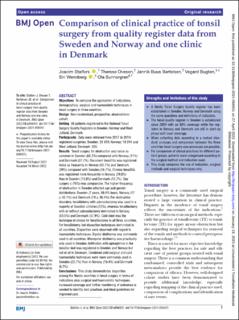| dc.contributor.author | Stalfors, Joacim | |
| dc.contributor.author | Ovesen, Therese | |
| dc.contributor.author | Bertelsen, Jannik Buus | |
| dc.contributor.author | Bugten, Vegard | |
| dc.contributor.author | Wennberg, Siri | |
| dc.contributor.author | Sunnergren, Ola | |
| dc.date.accessioned | 2023-01-25T10:53:34Z | |
| dc.date.available | 2023-01-25T10:53:34Z | |
| dc.date.created | 2022-05-25T12:58:36Z | |
| dc.date.issued | 2022 | |
| dc.identifier.citation | BMJ Open. 2022, 12 (4), 1-11. | en_US |
| dc.identifier.issn | 2044-6055 | |
| dc.identifier.uri | https://hdl.handle.net/11250/3046217 | |
| dc.description.abstract | Objectives To compare the application of indications, demographics, surgical and haemostatic techniques in tonsil surgery in three countries.
Design Non-randomised, prospective, observational cohort.
Setting All patients registered in the National Tonsil Surgery Quality Registers in Sweden, Norway and West Jutland, Denmark.
Participants Data were retrieved from 2017 to 2019; registered surgeries: Sweden: 20 833; Norway: 10 294 and West Jutland, Denmark: 505.
Results Tonsil surgery for obstruction was twice as common in Sweden (62.2%) compared with Norway (31%) and Denmark (27.7%). Recurrent tonsillitis was registered twice as frequently in Norway (35.7%) and Denmark (39%) compared with Sweden (16.7%). Chronic tonsillitis was registered more frequently in Norway (29.8%) than in Sweden (13.8%) and Denmark (12.7%). Day surgery (>76%) was comparable. The higher frequency of obstruction in Sweden affected age and gender distributions: Sweden (7 years, 50.4% boys), Norway (17 y, 42.1%) and Denmark (19 y, 38.4%). For obstructive disorders, tonsillotomy with adenoidectomy was used in a majority of Swedish children (72%), whereas tonsillectomy with or without adenoidectomy dominated in Norway (53.5%) and Denmark (57.9%). Cold steel was the technique of choice for tonsillectomy in all three countries. For tonsillotomy, hot dissection techniques dominated in all countries. Disparities were observed with regard to haemostatic techniques. Bipolar diathermy was commonly used in all countries. Monopolar diathermy was practically only used in Sweden. Infiltration with epinephrine in the tonsillar bed was registered in Sweden and Norway but not at all in Denmark. Combined cold surgical and cold haemostatic techniques were more commonly used in Sweden (22.7%) than in Norway (10.4%) and Denmark (6.2%).
Conclusions This study demonstrates disparities among the Nordic countries in tonsil surgery in terms of indications plus surgical and haemostatic techniques. Increased coverage and further monitoring of outcomes is needed to identify best practices and ideal guidelines for improved care. | en_US |
| dc.language.iso | eng | en_US |
| dc.publisher | BMJ Publishing Group Ltd | en_US |
| dc.rights | Navngivelse-Ikkekommersiell 4.0 Internasjonal | * |
| dc.rights.uri | http://creativecommons.org/licenses/by-nc/4.0/deed.no | * |
| dc.title | Comparison of clinical practice of tonsil surgery from quality register data from Sweden and Norway and one clinic in Denmark | en_US |
| dc.title.alternative | Comparison of clinical practice of tonsil surgery from quality register data from Sweden and Norway and one clinic in Denmark | en_US |
| dc.type | Peer reviewed | en_US |
| dc.type | Journal article | en_US |
| dc.description.version | publishedVersion | en_US |
| dc.source.pagenumber | 1-11 | en_US |
| dc.source.volume | 12 | en_US |
| dc.source.journal | BMJ Open | en_US |
| dc.source.issue | 4 | en_US |
| dc.identifier.doi | 10.1136/bmjopen-2021-056551 | |
| dc.identifier.cristin | 2027362 | |
| cristin.ispublished | true | |
| cristin.fulltext | original | |
| cristin.qualitycode | 1 | |

